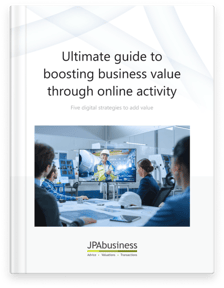
In this week's blog I'm sharing Chapter 1 of our new ebook: Ultimate guide to boosting business value through online activity.
In Chapter 1 I tell the story of... 'us' – JPAbusiness – and how we have transitioned from only receiving new business leads through past clients and other contacts, to now receiving 70% of leads through online sources.
You can:
- read Chapter 1 below,
- download the complete ebook, or
- watch a video where I discuss the chapter on our YouTube channel.
How to engage and communicate with customers and suppliers online
Back in 2014, when we wrote our first online value eBook, the primary way of engaging with customers and suppliers, no matter what the business sector, was still largely face to face.
In a perverse way, it was an ‘undynamic’ way of communication – a sort of set-piece, discrete event. You got in your car, or on a plane, travelled to your customer or supplier’s place of business, met over a conference table or counter, and then went away again. Transaction done and/or meeting over.
The online environment and digitisation of interaction through apps, text, group chat, social media channels, video calls and so on, mean engagements with customers and suppliers can be much more dynamic and comprehensive.
That’s a positive in terms of affirmation of your performance from a customer, and it can also be negative (in a positive way) in terms of learning pretty quickly if a customer is unhappy.
Case study
Our first case study is… ‘us’ – JPAbusiness.
In our business today, about 70% of our clients – for transactions, advisory and valuation services – initially engage and get to know our offering through our digital channels.
Apart from direct and indirect referrals, from past clients and other connections in our network, our sale inquiries originate and germinate in a completely virtual environment.
A typical inquiry comes about as follows:
- A prospect searches, say, ‘business valuation for manufacturing firm’ in Google or another search engine.
- They identify a link to a recent blog post or eBook we have released on the topic.
- They download the eBook and/or explore our website and other social media channels for further information on our services, conversations, and other client experiences.
- They compare us to what other firms might be offering.
- They send an inquiry email or place a call.
- At this point we get to converse and discuss the prospect’s needs and our services – they are typically well-educated about our services and often quite focused – zeroing in on the issues important to them as decision support to deciding whether to engage us or not.
- The physical interaction adds value to the virtual lead-up by allowing us to show understanding, customisation and passion for the needs, issues and solutions required.
- It’s a perfect symmetry between a virtual and physical sales process that delivers transparency, relevant information and confidence; and therefore, often leads to a high strike rate (over 50%) in successful sales engagements.
That’s the initial engagement process for us these days, and it’s delivering value to our business every day.
How to track engagement with customers and suppliers
But how do we measure the results of that engagement, to make sure we’re on the right track?
And, if we ever wanted to exit the business, how do we prove the value of that engagement to an impartial third party?
In our case, we’ve invested in customer relationship management (CRM) software that allows us to track this online activity.
It also allows us to engage with the broader JPAbusiness ‘community’ – which may mean current clients, former clients, suppliers, prospects, advisors, you name it – across multiple online platforms at the same time.
This allows us to both share messages about our offerings and receive feedback about our services in a much more streamlined and dynamic way than ever before.
What it means for business value
When valuing a business, we look closely at how dynamically the firm is engaging with its customers and suppliers.
For example, when valuing a business – both today and in pre-digital times – we ideally want to see that it has a diverse customer base.
Whether there are 30 or 300 customers, we’re looking for diversity of spend (e.g. no customer responsible for more than 5-10% of total revenue) and repeatability of spend across a number of years or months.
These days we also consider how customers are buying – are they buying online, click and collect, in a physical way, or a mix of these? Are they visiting the business’ website first? Are they following the business and engaging with it on social media during the purchase process? This is not just for retail products, e.g. sporting goods, but also for services, e.g. trades, consults, projects etc.
Many clients report that even if only 5% of their revenue comes through pure online purchasing, a significantly higher percentage (sometimes 50%+) may well originate via online enquiry.
How to put a price on ‘engagement’
So how do you – as a business owner or manager – translate this online engagement into value that a business valuer can put a price on?
Your social media presence is a good start.
No matter what a business owner says about their customer relationships, a valuer can discover a lot about a customer’s experience by simply looking at what they are saying about the business on social media. There is no hiding!
Another tool is CRM software that tracks and measures their online engagement with customers.
This allows you, and someone assessing the value of your business, to know:
- if a customer engages as a result of a website landing page that’s promoting a new product;
- if a customer engages as a result of paid, online advertising;
- how often a customer is engaging with your online channels, and so on.
Having that kind of intelligence recorded is an important ‘health’ factor for a business. It shows a valuer that the business is closely monitoring what customers are doing and why they are doing it.
And being able to show a valuer the trends and results of that engagement will help them assess the strength and sustainability of your business performance.
JPAbusiness offers a range of business valuation and advisory services. If you would like to discuss strategies to help you grow the value of your business, contact the team on 02 6360 0360 or 02 9893 1803 for a confidential, obligation-free discussion.

